Here’s the deal on Beneficial Insects (aka good garden bugs).
You may think all insects are pests or bugs, but that simply is not the case.
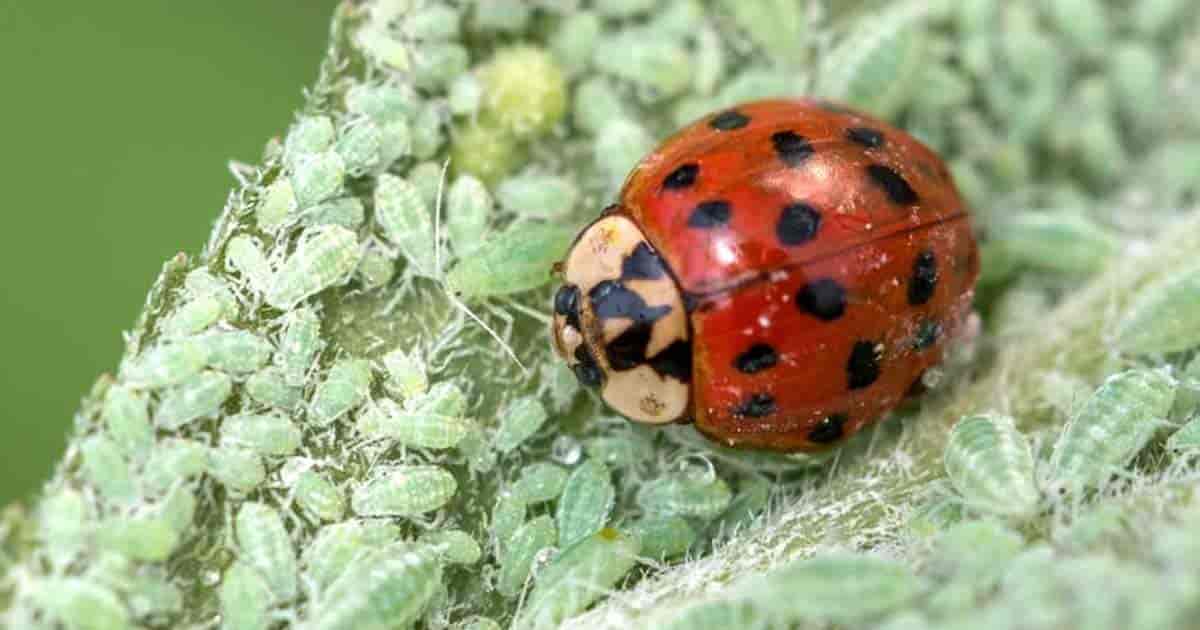
There are many beneficial insects (good bugs) that would be all too happy to help you chase true bugs out of your yard and garden if you’d just give them a chance.
In this article, we discuss the many varieties of good garden insects and other friendly garden fauna.
We also share advice to help you attract these natural enemies of garden pests and encourage them to stay. Read on to learn more.
- Integrated Pest Management (IPM)
- What Are True Bugs?
- What Are The Best Beneficial Insects?
- Ladybugs In The Garden
- Wasps And Yellow Jackets – Yes Good Insects!
- Braconid Wasps #1 For Controlling Tomato Hornworms
- Ichneumon Wasps
- Bees
- Praying Mantis
- Spiders
- Ground Beetles
- Soldier Beetles
- More On Important Predator Soldier Beetles
- Rove Beetles
- Tiger Beetles
- More on the Tiger Beetle: High-Speed Natural Bug Killers For The Garden
- Aphid Midge
- More on the Aphid Midge – Attracting The Voracious Aphid Killer To Your Garden
- Sow-bugs, Millipedes & Centipedes
- Assassin Bugs
- Damsel Bugs (aka: nabids)
- Spined Soldier Bugs
- Green Lacewings
- Minute Pirate Bug
- Tachinid Flies
- Hoverflies
- Learn How To Naturally Fight Aphids With The Beneficial Hoverfly
- Mealybug Destroyer – Ladybird Beetle – Cryptolaemus montrouzieri
- Predatory Mites
- Fungus Gnat Predator (Stratiolaelaps scimitus)
- Beneficial Nematodes
- Other Friendly Garden Fauna
- How Do You Create A Welcoming Home For Good Bugs And Other Garden Helpers?
- How To Use Beneficial Insects In The Garden
- Can You Live With Bugs?
Integrated Pest Management (IPM)
In mid-century America, we were told that we could enjoy “better living through chemistry”.
As a result, many people abandoned the organic farming and gardening practices that had been used for centuries and opted for chemical pesticides and fertilizers instead.
The result has been contaminated water and soil, an unbalanced environment, loss of friendly fauna and less healthy produce.
Today IPM is gaining favor with commercial farmers and home gardeners.
This concept combines the sensible use of chemicals with organic and biological pest control.
Controlling pest problems biologically involves partnering with friendly fauna (insects, arachnids, reptiles, and birds) to keep your unfriendly fauna (pest) population under control.
Why Is Biological Pest Control So Desirable?
Biological pest control is safe and non-toxic.
With few or no chemicals in your garden, you can enjoy a healthier outdoor experience and healthier garden produce.
Beneficial insects and other friendly garden inhabitants are interesting.
When you take care to create a balanced, welcoming environment in your yard and garden, it will soon be filled with pleasant beneficial bugs.
Chemical pesticides kill everything.
When you rely on chemicals to kill the pests in your garden, you also kill the friendly fauna.
Chemical pesticides kill good bugs, and they can also kill birds, lizards, turtles, frogs, and toads that may feed on the poisoned insects.
Biological control of insect pests is free.
There are some types of friendly fauna you may need to purchase to add to your garden. Ladybugs or lady beetles for example.
For the most part, you just need to set up a welcoming environment to attract natural helpers to your yard. If you build it, they will come.
Pests can develop resistance to chemical pesticides, but they can never develop resistance to natural predators.
NOTE: According to the Pesticide Action Network it is estimated that somewhere between 500 and 1,000 weed and insect species have developed resistance to pesticides since 1945.
What Are True Bugs?
Most of us assume and use the word “bug” and “insect” to identify the same “garden pests.”
However, when Entomologists (aka those people who study insects) use the term “bug,” they are very specific in referring to “true bugs” from the order Hemiptera.
True bugs SUCK fluids and juices from plants. Several true bugs like bedbugs also feed on animals.
The mouthparts are the main difference between insects and true bugs. True bugs have mouth parts specially designed to suck juices.
True bugs all go through an incomplete metamorphosis. The nymphs hatch from their egg and the nymph is a miniature version of the adult bug.
Below are some examples of several common true bugs you will find in the garden:
- Aphids – also called Plant Lice
- Scale Insect “Bugs”
- Mealybugs on plants
- Leaf Hopper Bugs
- Stink bugs
- Swarming Whitefly
What Are The Best Beneficial Insects?
The best beneficial insects for your garden will vary depending on where your garden is and what sort of pests you have to deal with.
Remember, if you have a certain type of pest, it will naturally attract the predator you need.
You need to give it a little time and lay off the pesticide.
Having said that, here are some of the top insect helpers for yards and gardens.
Ladybugs In The Garden

Pretty red and black ladybugs sometimes called lady beetles are popular and practical garden helpers.
At every stage of their lives, they lay waste to a wide variety of insect pests.
Adult ladybugs are voracious predators best known for eating aphids and other soft-bodied insects. A single beetle can eat as many as sixty aphids every day.
This adds up to about 5000 in the course of the beetle’s life. Ladybugs also eat mites, leafhoppers, and mealybugs.
Ladybugs go through life quite carefree as long as they are not confronted by pesticides.
They have no natural enemies because they happen to smell and taste terrible. Although, I’ve never eaten or tasted one.
Females produce several sets of offspring every season, and in the larval stage they also eat insect pests.
It’s important that you learn to identify genuine ladybugs because there are some look-alikes that are not at all beneficial.
For example, the Mexican potato beetle looks a little like a ladybug.
Some gardeners have accidentally introduced these bugs to their gardens and have sorely regretted it.
Mexican potato beetles will wreak havoc on your garden, and they also bite.
Beneficial Insects in Action – Ladybugs and Parasitic Wasps
How Do You Attract Ladybugs?
If you have aphids in your garden, blast the aphids off plants with water instead of spraying with chemicals.
The survivors will attract some ladybugs.
Planting dill and fennel will also attract ladybugs.
These plants are attractive to many beneficial insects and butterflies, making them good additions to any landscape.
Details on How To Use Lady Bugs In The Garden
Wasps And Yellow Jackets – Yes Good Insects!
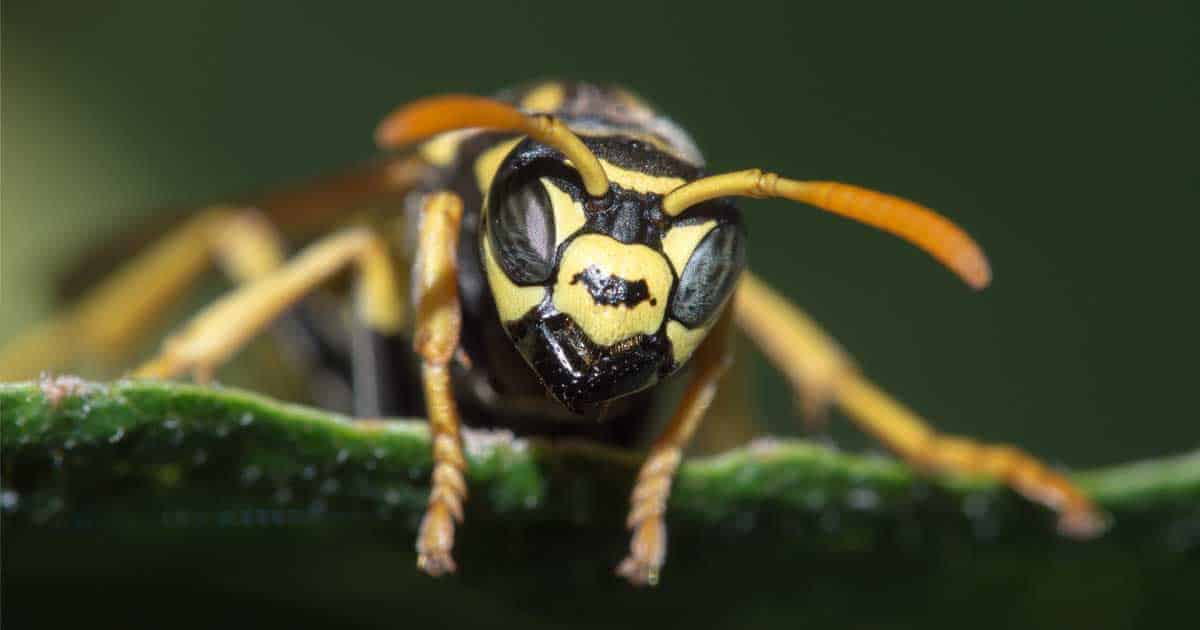
Even though you might think of yellow jackets and wasps as pests, the fact is they are really very beneficial.
They feed a wide variety of pest insects to their young, and eat blow-fly and housefly larvae.
Even so, you might think it’s not worth having them around if you risk being stung.
The key to avoiding being stung by wasps is to leave them alone.
Wasps typically sting when their nesting places are disturbed. So leave out of the way wasp and yellow jacket nests alone.
Nests in highly trafficked areas (e.g. your front porch) should be humanely removed and relocated.
More on Wasps And Natural Pests Control
Braconid Wasps #1 For Controlling Tomato Hornworms

Like tachinid flies, these non-aggressive wasps are parasitoid insects. They lay their eggs in or on the body of the tomato hornworm.
When the eggs hatch, the larvae feed on the caterpillar gradually until it becomes a mere “shell” of its former self.
If you see hornworms dragging themselves around in a stupor or gruesomely festooned with white braconid wasp cocoons, just leave them alone.
When the larvae mature, the hornworm will be dead and you’ll have more helpful wasps!
Female braconid wasps can lay as many as 50-400 eggs at a time. Braconid wasps can very strongly impact your tomato hornworm population.
Tomato hornworms are the preferred hosts for braconid wasp larvae.
But if no wasps are present the female wasp will lay eggs on other types of caterpillars, including:
- Codling moth caterpillars eating leaves
- Garden webworms
- Cabbage worms
- Tobacco hornworm
- Aphids
- … other types of insects and insect larvae
How Do You Attract Braconid Wasps To Your Garden?
Adult wasps eat pollen and drink nectar, so keep them happy with:
- Fern-leaf Yarrow
- Common Yarrow
- Lemon Balm
- Parsley
- Carrots
- Dill
Leave some broccoli stalks standing in the wintertime to give shelter to braconid species that specialize in eating cabbage worms.
Ichneumon Wasps
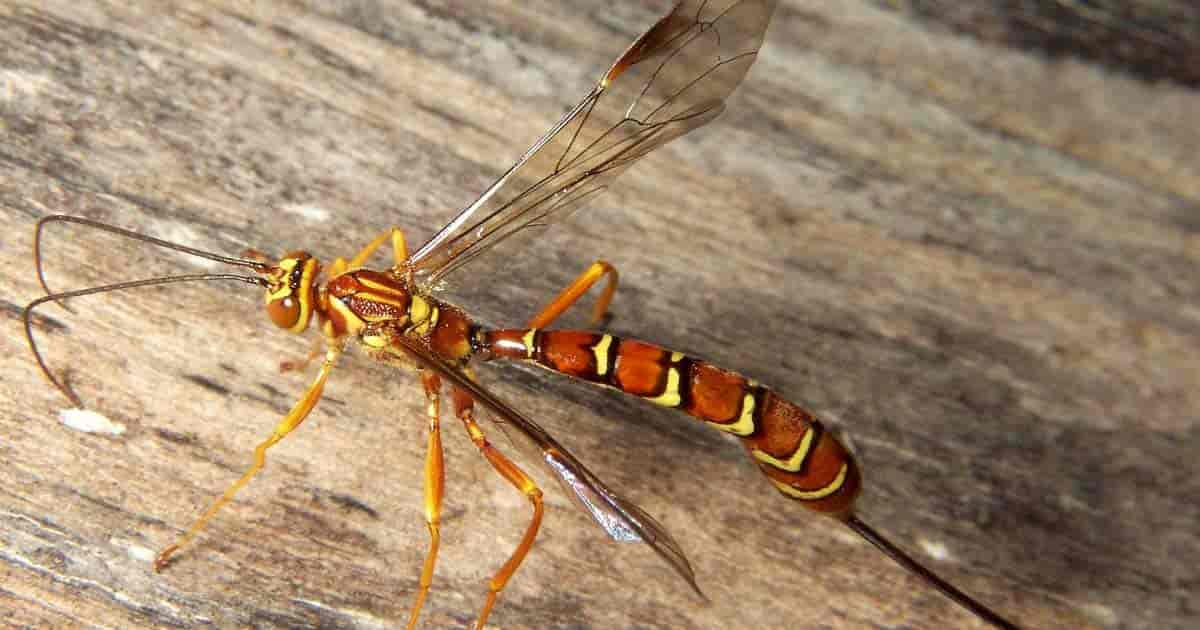
These slender, non-aggressive, non-stinging wasps have very long antennae made up of sixteen or more segments.
Female ichneumon wasps have very long ovipositors.
This is the thin, tube-like appendage used for egg-laying. It is positioned like a stinger, but the ovipositor is completely harmless.
In North America, there are thousands of species of this wasp, and many of them look very much alike.
Most are gray, brown or black, but some species have bright colors and patterns. A few mimic their stinging cousins with yellow and black bands.
Ichneumon wasps are parasitoid wasps. The females lay their eggs inside the body of a host insect where they hatch.
The larvae feed on and consume the host as they grow and mature.
Favored hosts include the larvae of:
- Butterflies
- Beetles
- Spiders
- Wasps
- Moths
- Ants
- Bees
- Flies
Bees

There are many different types of bees that may visit or take up residence in your garden.
All are desirable. Here are a couple of the most popular types.
Bumblebees are plump, cute and fuzzy. They are typically black and yellow striped, but some species are tan and black or even orange and black.
They are excellent pollinators of cool-season crops, such as vetch and alfalfa.
These are both important crops for feeding livestock. Other commercial crops that especially benefit from bumblebee pollination are cranberries and cotton.
In the home garden, they are most adept at pollinating:
- Watermelon
- Strawberries
- Raspberries
- Blueberries
- Cucumbers
- Eggplants
- Cabbage
- Peppers
- Carrots
- Squash
- Apples
- Plums
Bumblebees make a small nest, and this makes them very good for use in greenhouses.
In fact, they are used commercially to pollinate hothouse tomatoes.
Honeybees are major pollinators. They pollinate about eighty percent of the vegetables, fruits, nuts and grain grown in the United States.
These bees were imported to North America from Europe during colonial times. In addition to pollinating most of our food, they also produce valuable products such as:
- Royal jelly
- Beeswax
- Propolis
- Honey
Scientists are currently working on research that may lead to the use of bee venom to help alleviate arthritis pain.
How Can You Attract Honeybees?
It’s easy to see how having a thriving bee population is beneficial in many ways, yet honeybees are dying out in great numbers these days.
Luckily, home gardeners can help keep the honeybee population strong by keeping a diverse butterfly/pollinator garden filled with a wide variety of pollen-producing flowers.
Honeybees are also attracted to the blossoms of food crops, so planting such common garden plants as squash, peppers and tomatoes will encourage them to visit you.
They also pollinate berry and fruit blossoms.
It’s also a good idea to give honeybees a place to live! Check out this Basic Beekeeping Starter Kit at Amazon.
Praying Mantis

The praying mantis (or preying mantis) is a large, interesting looking, gregarious creature. An old-fashioned name for this striking insect is “devil’s horse”.
Praying mantis come in a range of colors from deep brown to bright green, all intended to provide camouflage.
The mantis is a voracious predator in the true sense. Preying mantis roams about, concealed by leaves and sticks, seeking out prey.
It eats a wide variety of insects, including:
- Grasshoppers
- Cockroaches
- Caterpillars
- Crickets
- Beetles
- Moths
…and many more. Basically, mantis’ will eat just about any bug they can catch.
How Do You Attract Praying Mantis?
To attract praying mantis provide them with good hiding and hunting grounds. They need shrubs, bushes and tall grass for lurking.
Plant dill, fennel, cosmos, marigolds and other very leafy plants attractive to potential prey.
Preying mantis like to find a good point of concealment and sit very still, watching for prey.
They are able to turn their heads a full 180 degrees to keep a very effective lookout. Purchase egg cases of Praying Mantis to introduce them into your garden.
Spiders

Spiders in your yard and garden and even in your house spiders are a good thing.
The vast majority of spiders are not venomous and would greatly prefer not to bite you or have anything to do with you.
Instead, they are focused on capturing and eating pest insects, including:
- Grasshoppers
- Caterpillars
- Aphids
- Moths
- Fruit Flies
..and many other types of pests.
How Do You Attract Spiders To Your Garden
A healthy spider population consists of both hunting spiders and web-weavers.
For web-weaving spiders, provide trees and trellises and other out-of-the-way places for web spinning.
Hunting spiders need a ground cover of leaves and/or slightly shaggy grass where they can hunt for ground dwelling pests, such as sod webworms.
Ground Beetles

There are more than 2500 species of ground beetles.
In fact, there are more species of beetles than any other insect order, and many of them are excellent garden helpers.
These nocturnal insects live in the leaf litter on the ground and hunt for prey at night. Some of their favorite prey include:
- Feeding on Colorado potato beetles
- Cabbage maggots
- Caterpillars
- Cutworms
- Snails
- Slugs
Ground beetles have voracious appetites and make short work of heavy infestations of pests, such as sod webworms.
How Can You Attract Ground Beetles?
Keeping a compost pile and/or planting perennials are both good ways to provide habitat for ground beetles.
Both provide consistent cover for these low-to-the-ground predators.
These perennial plants are attractive to ground beetles:
- Clover
- Amaranthus
- Evening primrose
In the spring and summer, ground beetles lay eggs on plants.
When they hatch, the larvae seek cover under leaf litter and in the soil, where they prey on soil-dwelling pests.
The larvae over-winter in the soil and mature to emerge as adult beetles in the springtime.
In addition to keeping insect pests under control, ground beetles and their larvae also help facilitate natural composting.
Soldier Beetles

These beetles make short work of smaller pests, such as soft-bodied insects and aphids. They also eat grasshopper eggs.
It’s easy to attract soldier beetles to your yard and garden by planting:
- Linden trees
- Marigolds
- Zinnias
More On Important Predator Soldier Beetles
Rove Beetles

These good bugs are another excellent addition to your biological pest control squad.
They are very often used in commercial agricultural and horticultural enterprises, as well as forestry.
They specialize in preying upon biting insects such as mosquitoes, biting flies and fleas.
Tiger Beetles

These exciting ground-dwelling beetle live in deep burrows.
Their lairs can be as deep as two feet. They eat a wide variety of spiders and insects.
These lively predators lay in wait for prey at the opening of the burrow.
When a tasty spider or insect ambles past, the tiger beetle leaps out and grabs the hapless victim in its long, pointy, serrated mandibles (jaws).
The tiger beetle then drags its prey into its lair to be eaten.
More on the Tiger Beetle: High-Speed Natural Bug Killers For The Garden
Aphid Midge

The aphid midge is a small fly, and its larvae are natural enemies of aphids.
In fact, they attack over sixty species of aphids by biting them on the joints of their legs and sucking them dry.
They leave behind, collapsed, blackened aphid hulls, still attached to the leaves they had hoped to devastate.
Aphid midge larvae are enthusiastic predators, killing more aphids than they actually need for growth and sustenance.
If aphid population numbers are high, aphid midge predation increases exponentially.
How Do You Attract Aphid Midges?
If aphids are present, aphid midges will be as well. Additionally, you can plant dill, along with pollen-producing plants.
Be sure to also provide a source of water.
More on the Aphid Midge – Attracting The Voracious Aphid Killer To Your Garden
Sow-bugs, Millipedes & Centipedes
You might think that sow-bugs, millipedes and centipedes are just creepy, but they are actually all that and more.
They are also beneficial. These little bugs (which are not insects) can be found throughout the garden under moist leaf litter or other organic matter.
They are very beneficial in the garden because they eat a vast array of detrimental, ground-dwelling insects.
They also facilitate efficient composting of organic matter.
That’s why it is best to just overlook them and leave them alone when you find them in your garden.
Give them a safe trip to the outdoors when you find them inside.
They are harmless to people and have no interest in eating our food or damaging our possessions.
They just want to live in leaf litter and eat bugs.
Unlike insects, none of these critters are six-legged.
Sow-bugs have 14 legs all-in-all and are land-dwelling crustaceans.
They are gray/brown and small, measuring no more than 3/4 of an inch in length, oval-shaped with overlapping scales.
Millipedes are arthropods. They look like small, brown worms, but they have 400 tiny legs and are quite slow moving.
Their bodies are made up of 200 segments (2 legs per segment) and they coil up when startled (or dead). They can grow up to 1.5 inches long.
Common centipedes (house centipedes) are more flat-bodied than millipedes.
They range in color from a yellow/brown to solid brown and may be slightly stripped.
They are arthropods and have 30 long, jointed, striped legs that carry them along at a rapid clip. They also have a pair of long antennae.
The stone centipede is very similar to the common centipede and can be found in the same sort of environment.
This good bug can grow to be 1 – 3/4″ inches long.
Centipedes eat a wide variety of ground-dwelling insects and spiders.
They also eat millipedes and sow bugs. Indoors they eat termites, moths, roaches, flies and silverfish.
While there are some unusual and exotic types of centipedes that can grow quite large and deliver a painful bite.
The ones you encounter in your garden will typically be about an inch long, and they won’t hurt you.
Garden centipedes are shy and retiring.
They do subdue their prey with a poisonous bite, but their jaws are not strong enough to pierce human skin.
You would have to go out of your way to get bitten by one.
In the event you do corner a centipede and get bitten, you may experience a little redness and swelling, but very little pain.
How Do You Attract Sow Bugs, Millipedes & Centipedes
These lowly creatures are unobtrusive good bugs, and you probably already have them in your yard and garden.
Just be sure to provide them some leaf litter and logs to hide under, and let them help you.
Assassin Bugs
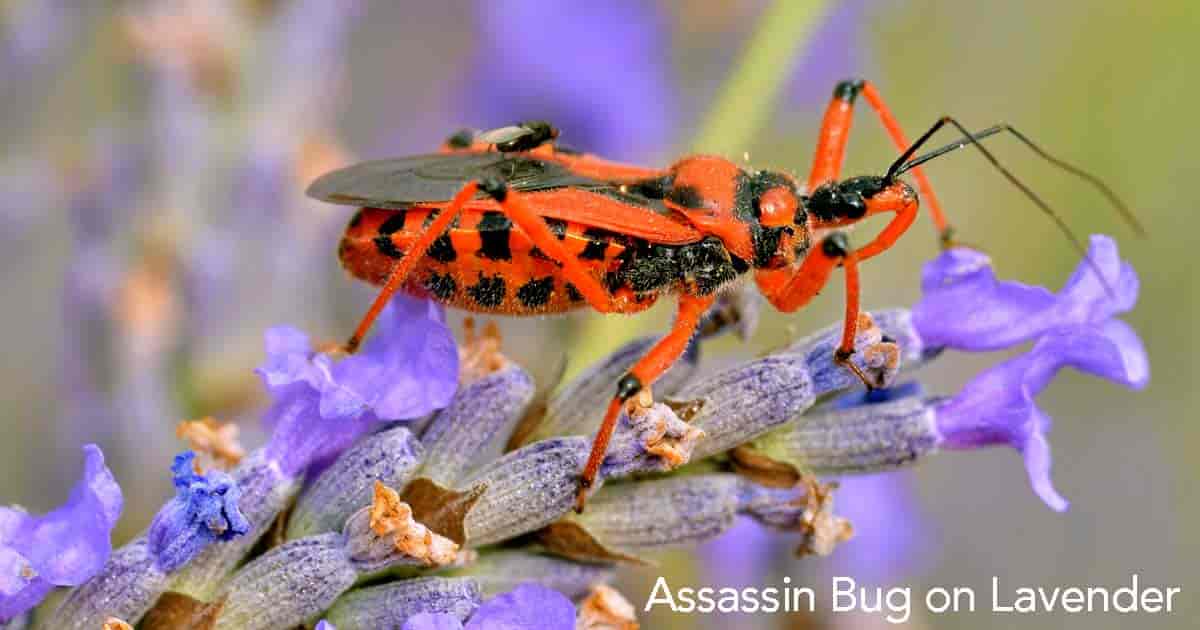
There are about 7000 different species of Assassin Bug.
You can recognize them by their long, thin “necks” and narrow heads. Their size ranges from .2 inches to 1.6 inches.
All species of assassin bug have three-segmented, pointed beaks which they use to pierce their prey and suck out its innards.
When not in use, the beak is curved under the body and held in place in a groove that runs between the insect’s front legs.
Assassin bugs are usually brown or black, but there are a few very colorful species.
Most bugs in this family live in the garden and prey upon pest insects.
Related: Do Assassin Bugs Eat Aphids?
However, a few (namely the Kissing Bug, the black corsair and the masked hunter (aka: masked bedbug hunter) seek out warm-blooded animals (including people) as prey.
They use their beaks to suck blood, and they can transmit diseases.
Luckily, these species make up a very small number of this insect family, and they are seldom encountered.
More on The Assassin Bug: “Scary” Natural Pest Control For Your Garden
Damsel Bugs (aka: nabids)
These good bugs look a little like assassin bugs, but smaller, smoother and slimmer.
The most common damsel bugs are brown, but some uncommon species are black.
They are generalist predators helpful in keeping a wide variety of insect pests under control in crops and gardens.
Among the insects they prey upon are:
- Colorado potato beetle nymphs
- Colorado potato beetle eggs
- Tarnished plant bug nymphs
- European corn borer
- Asparagus beetle
- Small caterpillars
- Corn earworm
- Cabbageworm
- Armyworms
- Green Leafhopper
- Sawfly larvae
- Moth eggs
- Aphids (organic control)
- Mites
How Can You Attract Damsel Bugs
These good bugs like bushy plants for hiding. Some good choices include:
- Peter Pan Goldenrod
- Spearmint
- Caraway
- Fennel
- Alfalfa
Spined Soldier Bugs
These cousins of stink bugs are a good addition to your garden because they eat Colorado potato beetle and Mexican bean beetle larvae and also caterpillars.
Without close inspection, it is easy to mistake soldier bugs for stink bugs. To tell the difference, look for spiny shoulders and legs.
You may occasionally catch one of these good bugs sucking on a plant for hydration, but they are not harmful to plants, and they don’t transmit disease.
Be sure to keep your plants well watered at all times, but especially if you find Spined Soldier Bugs in residence.
How Do You Attract Spined Soldier Bugs?
These garden helpers are attracted to all sorts of perennial flowers.
These plants give them shelter and provide a good place for egg laying and overwintering.
Green Lacewings
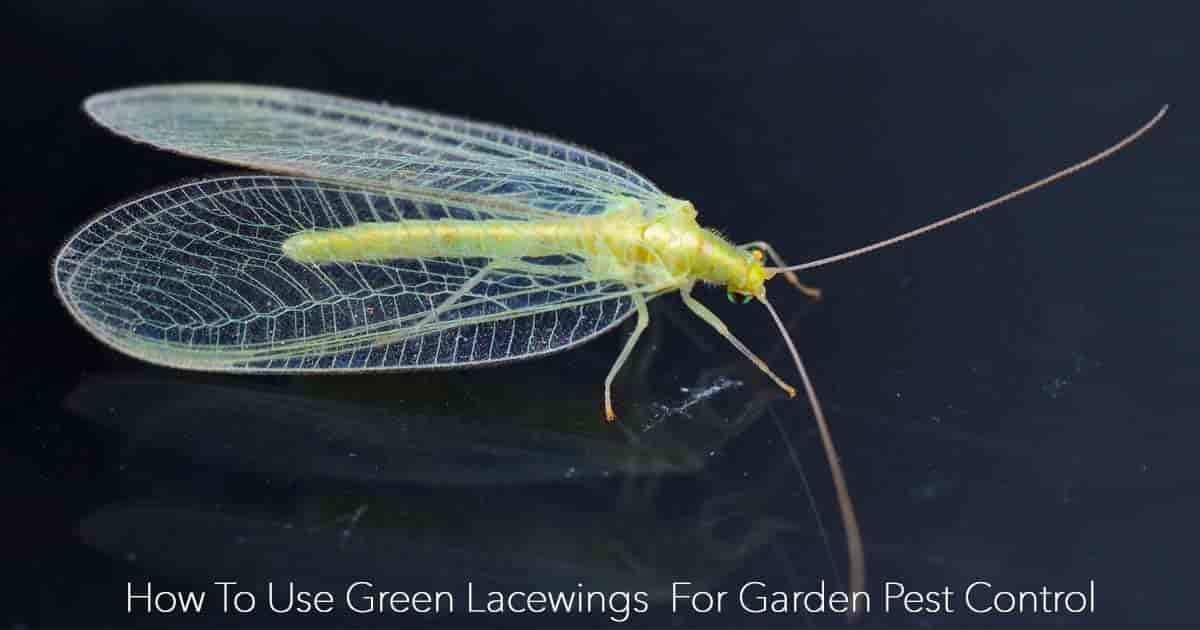
These pretty green bugs have a lovely lace design on their wings.
The adults bring an ethereal fairy-like presence to your garden, and the larvae are trundling little alligators with hook-like mandibles. Both adults and lacewing larvae prey upon soft-bodied insects like:
- Leafhoppers
- Whiteflies
- Mealybug infestation
- Aphids
The adults also feast on pollen and nectar in flower gardens.
How Do You Attract Green Lacewings?
Plant pollen-producing plants that provide nectar. Favored plants include:
- Golden Marguerite
- Dandelion
- Coriander
- Angelica
- Dill
The standard butterfly/pollinator garden would be attractive to green lacewings.
More on How To Use Green Lacewings For Garden Pest Control
Minute Pirate Bug
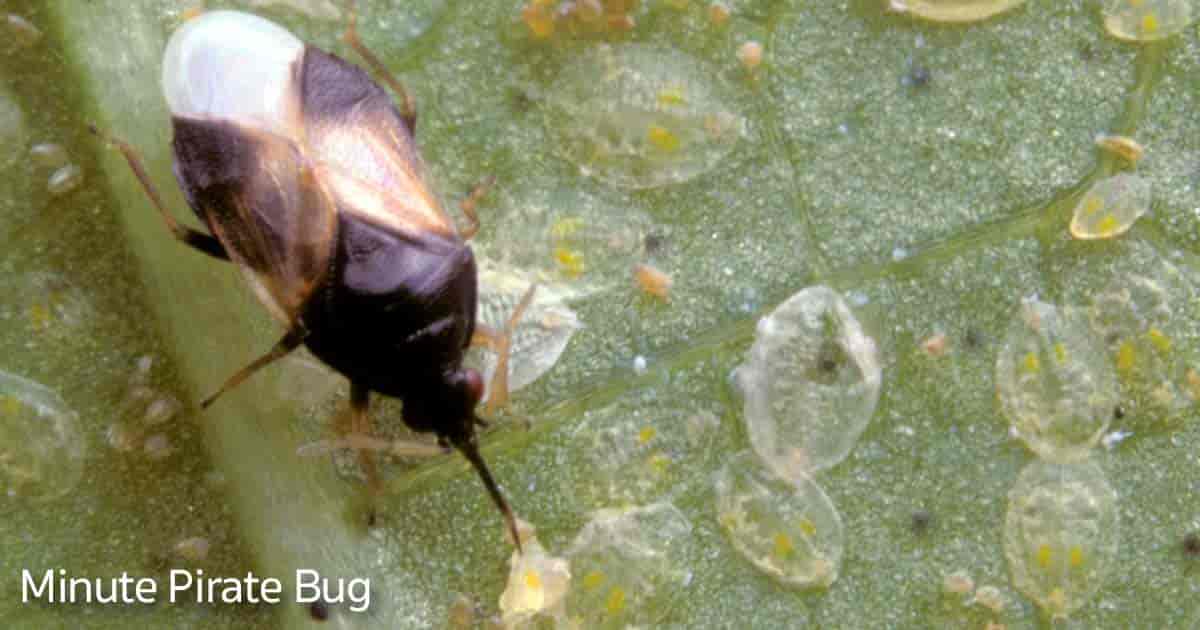
At all life stages, these bugs are enthusiastic hunters of bugs of all types – both good and bad.
If you have an overabundance of pest insects in your garden, the Minute Pirate Bug is the predator for you.
On the other hand, if you have a nice balance of good and bad bugs already, don’t go out of your way to introduce this one.
When it comes to pest consumption, the Minute Pirate Bug makes a real dent in the thrips, aphid and spider mite population.
A single pirate bug will eat as many as twenty thrips daily.
They also make short work of insect eggs and caterpillars (both good and bad).
Their tendency to eat whatever crosses their path makes them better biological pest control candidates for a controlled greenhouse setting than for an open garden.
In a greenhouse, they can make short work of an aphid, thrips or spider mite infestation.
In a garden, they may do that and kill off a significant portion of your other beneficial insects.
How Do You Attract Minute Pirate Bugs?
These little critters are especially fond of daisies and alfalfa, which attract a wide variety of pests.
They also like to hang around leaf piles because many pest insects dwell there.
More on Minute Pirate Bugs: Beneficial Pest Control With A Love/Hate Relationship
Tachinid Flies
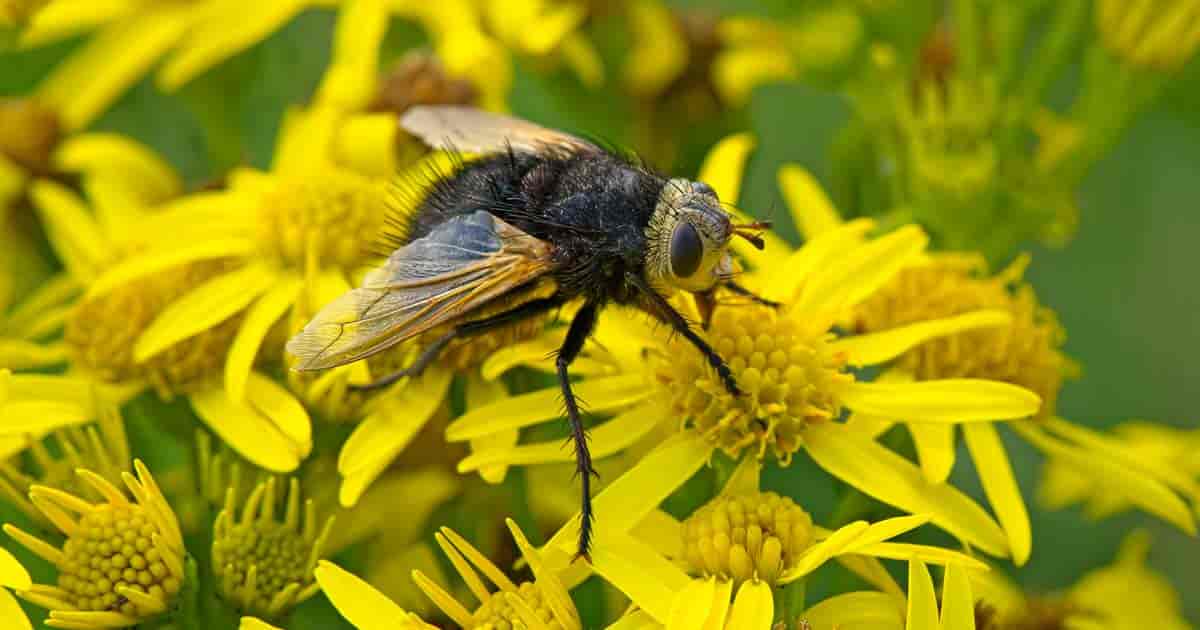
These are parasitoid flies that lay their eggs inside of pest insects (mostly caterpillars).
The eggs hatch and the larvae consume the bad bug from the inside out.
Some types of tachinid flies lay eggs on vegetation that is commonly eaten by caterpillars.
When an unsuspecting caterpillar comes along and eats the foliage, it also eats the eggs and mayhem ensues.
Insects that are subject to habitation by tachinid fly larvae include:
- Peach twig borers
- Japanese beetles
- Cabbage loopers
- Tent caterpillars
- Pink bollworms
- Codling moths
- Gypsy moths
- Squash bugs
- Armyworms
- Cutworms
- Sawflies
How Do You Attract Tachinid Flies?
You probably don’t need to attract them. You probably already have them but don’t know it.
There are many species of this type of fly, and although some can be as large as a housefly, most are much smaller.
DETAILS: How To Control Garden Pests With Beneficial Tachinid Flies
They don’t pester people or food as houseflies do, so you may never notice them.
Tachinid flies (and many other types of flies) are also beneficial because they are pollinators.
In fact, flies and even mosquitoes are very valuable pollinators.
Plant any or all of these plants to attract these valuable flies:
- Buckwheat
- Coriander
- Cilantro
- Parsley
- Carrots
- Clover
- Dill
Hoverflies

Another valuable beneficial insect is the hoverfly. These flies eat pollen, but their larvae eat:
- Juice sucking plant scale bugs
- Caterpillars
- Aphids
To attract the adult flies to your garden, be sure to plant:
- Common yarrow
- Fern-leaf yarrow
- Basket of gold
- Statice
- Dill
Learn How To Naturally Fight Aphids With The Beneficial Hoverfly
Mealybug Destroyer – Ladybird Beetle – Cryptolaemus montrouzieri
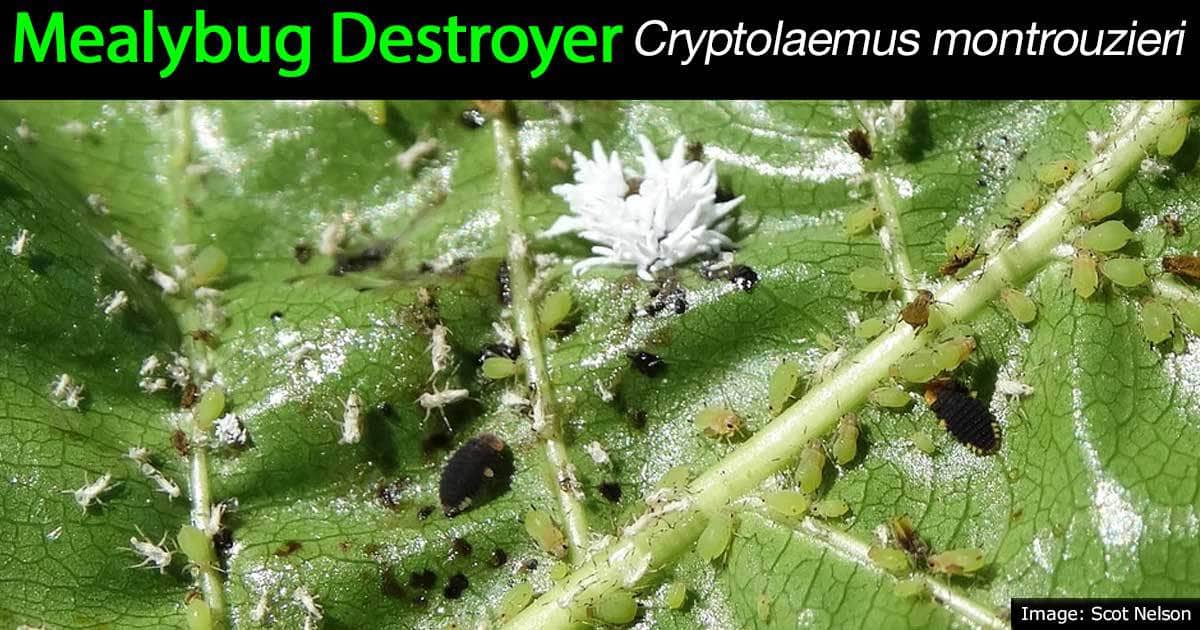
Count on this predator to live up to its descriptive name. If you see white, cottony patches of fluff on your plants, you know you have mealybugs.
These little invaders suck the sap out of plants and can cause a great deal of damage.
Mealybug destroyers make short work of most species of mealybugs.
In fact, a single mealybug destroyer can eat as many as 250 mealybug larvae in a day.
How Do You Attract Mealybug Destroyers?
To attract these helpful insects, be sure to plant plenty of:
- Sunflower
- Goldenrod
- Angelica
- Fennel
- Dill
DETAILS on Using The Mealybug Destroyer In The Garden
Predatory Mites
These tiny predators are the sworn enemies of spider mites.
In the wild, they thrive in humid settings, so unless you are in a tropical setting you probably will not attract them to your garden.
However, they can easily be introduced to a greenhouse or other controlled setting.
When the spider mite problem has been eradicated, predatory mites eat pollen, so be sure to plant some flowering plants to keep them happy.
Fungus Gnat Predator (Stratiolaelaps scimitus)
These tiny, soil-dwelling predators prey upon fungus gnat larvae, along with a number of other harmful, soil-dwelling insect pests.
These garden helpers are available for purchase and typically come in packages of 25,000 at various stages of development, packed in a mixture of peat and vermiculite.
All you have to do is sprinkle them over your garden soil. They get to work right away piercing pest larvae and consuming their insides.
If you plan to introduce fungus gnat predators to your garden, be sure not to use pesticides in the garden for several weeks prior to setting them loose.
Beneficial Nematodes
Another ground dwelling predator is the beneficial nematode.
This not a good “bug” or insect at all. Beneficial nematodes are natural parasites that take up residence in a wide variety of ground dwelling insects.
They consume more than 200 different types of insect larvae that live in garden soil.
Among these are:
- Japanese beetles
- Fungus Gnats
- Weevils
- Fleas
Just as with fungus gnat destroyers, you can buy beneficial nematodes to add to your garden soil.
If you have very harsh winters, you should purchase them and add them annually in the springtime. You can apply them with a hose-end sprayer.
Check out the BioLogic Ecomask Beneficial Nematodes at Amazon
Other Friendly Garden Fauna
Earthworms
Another ground-dwelling garden helper is the earthworm.
While they do not prey on garden pests, they do help compost your kitchen and yard scraps and aerate your soil.
To encourage earthworms to live under your garden, use a natural mulch (e.g. leaves, wood chips, pine needles, etc.) and avoid the use of chemical pesticides and fertilizers.
Instead, keep a compost pile and use your own natural, organic compost to feed your garden.
Frogs & Toads
These delightful garden dwellers are real powerhouses when it comes to eating bugs.
A toad or frog can eat dozens of bugs a day, and that adds up to thousands in the course of a summer.
How Do You Attract Frogs & Toads To Your Yard?
Unless you live near a creek, stream, river or pond, you probably won’t attract frogs, but if you keep some damp spots and dishes of water in your yard and provide hiding places and shelter, you can attract toads.
To make a simple toad house, just lay a clay pot on its side under a bush and bury it about halfway into the soil so that it has an earthen floor and a cozy roof.
Toads love to sit inside these little houses and look out. This is a good use for broken pots!
Lizards & Garter Snakes
All sorts of lizards are interesting and beneficial in the garden. They eat all manner of insects, including:
- Grasshoppers
- Cockroaches
- Crickets
- Beetles
- Moths
- Grubs
- Flies
Garter snakes and corn snakes are also excellent garden helpers.
Garter snakes eat grasshoppers and crickets and lots of other ground-dwelling bugs. Corn snakes eat those and also rats and mice.
Although you may be worried about being bitten, the fact is most snakes are more afraid of people than vice-versa.
For the most part, if you leave them alone, they’ll leave you alone.
Do become familiar with the types of snakes native to your area.
Whenever you see any snake, just give it a wide berth. If you recognize a venomous snake, call local authorities to deal with it.
How Do You Attract Lizards & Garden Snakes?
If you have a healthy garden and landscape, you probably already have some lizards and snakes in residence.
They like full bushes, thick ground cover and features such as wood piles or rock gardens for hiding and hunting.
Box Turtles, Tortoises & Terrapins
Turtles, terrapins and tortoises are members of the order, Testudines.
No matter where you live, some member of that order is bound to be native.
Most types are also endangered, so if you can provide habitat for one or more of these charming, bug-eating creatures, you’ll be doing the animal, yourself and the earth a favor.
Land-dwelling turtles eat a wide variety of bugs, but some of their favorite foods are slugs and snails.
They are also scavengers and will eat fallen fruits and veggies in the garden.
How Do You Attract Land Turtles?
Like toads, land turtles like to have soft, moist earth and plenty of good hiding places.
Leave some areas of loose leaf litter, compost heaps and brush piles for them to hide and hibernate.
Turtles also like to have sunny areas off the beaten path for basking and to lay eggs.
To have turtles in your garden, focus on attracting them, or contact a turtle rescue to see about adopting one.
Since they are endangered, don’t collect them in the wild, and don’t purchase them as this only encourages the decimation of their numbers.
Birds
Birds of all kinds will help keep your yard and garden free of insect pests while they fill the air with color and song.
Become familiar with the types of birds native to your area.
Plant fruit and berry bushes and provide feeders, water sources and nesting houses to attract them year round.
How Do You Create A Welcoming Home For Good Bugs And Other Garden Helpers?
One of the best things you can do to attract natural predators to your yard is to let it go a little wild.
Be sure to provide hiding and nesting places, food and water.
Plant-specific types of flowers and fruit and nut-bearing shrubs and trees to draw in the types of garden helpers you need most.
A few housekeeping tasks you may wish to attend before you begin.
If you plan to purchase a certain type of beneficial insect or creature, check your city codes to be sure the bugs you have in mind are permitted.
Talk with your neighbors and let them know what you are doing.
They may pull out the bug spray if they begin to see lots of insects around and don’t understand that these are the good guys.
Take a census of your current insect residents.
Search around your yard and garden to see what you already have on the premises.
Identify both good and bad bugs in your garden and try to get an idea of the population levels on hand.
Be careful not to introduce a “prey-specific” of beneficial insect unless you have a fairly good representation of its favored prey ready to be hunted.
If you introduce predators but have no prey, they will naturally go elsewhere.
How To Use Beneficial Insects In The Garden

Who wouldn’t like to have some extra help in dealing with garden pests.
Having a patrol squad out cleaning up little outbreaks of black aphids on plants, thrips, and white bugs on plants (mealybugs). One of the best ways to get help naturally is with – Beneficial Insects.
In this excellent video by Patricia Boudier of GrowOrganic.com, Patricia talks about what would be called the “general predators” – praying mantis, lady bugs and green lacewings. She shares:
- Tips on when to release lady bugs, storing and adding some moisture when releasing
- Tips on how to release Praying mantis, tying off it’s “shell” and protecting against ants until ready for work!
- When to release lacewings which eat aphids, thrips, mealybugs, whiteflies and lunch on spider mites.
- How beneficial insects arrive when ordered
- Tips on keeping these beneficial insects around for reproduction.
It’s important to remember that when you are using beneficial insects you must be aware that any sprays you use to control pest may harm the beneficials as well, as Patricia says – “Grow Organic.”
Can You Live With Bugs?
A garden that is allowed to go a little wild and is given a respite from harsh chemical pesticides and fertilizers is a healthy, friendly and welcoming place.
Having a garden teeming with life may seem a little alarming at first, but when you get a good balance in your garden, your plants will thrive and so will you.
Teaming up with nature to create a thriving garden is not an instant fix.
It takes time for your soil to rebound, your natural predators to congregate and results to begin.
Once the process starts, though, you will find yourself delighted day after day as your plants flourish and your workload lessens.